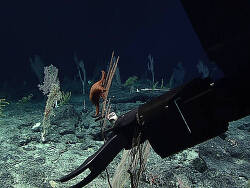Info
Calyptrophora lyra was discovered on the western Pacific seamount "Godin" approx. 50 km south of Wake Island in a water depth of 1409 meters and discovered and collected with the help of an ROV.
During the collection, the polyps of the colony were removed from grazed by a large orange-colored starfish.
The holotype of the deep-water coral is uniplanar and clearly lyrate branching, although not the entire colony was collected.
The collected colony fragment has a length of 22 cm, unbranched branches at intervals of 14 - 19 mm, which grow parallel to each other in one plane.
The polyps are directed downwards and are arranged in whorls of four, relatively close together, individual polyps have a horizontal length of 2.3 - 2.8 mm, the polyps are orange-colored, the axis is bronze-colored.
Calyptrophora lyra belongs to the wyvillei species complex (sensu Bayer 2001), which comprises eight to nine species in which the polyps are downwards (see key, couplet 1'):
Calyptrophora wyvillei Wright, 1885 (New Zealand, Hawaii), Calyptrophora agassizii Studer, 1894 (Galápagos), Calyptrophora reedi Cairns, 2018, (Galápagos), Calyptrophora clinata Cairns, 2007a (New England Seamounts), Calyptrophora diaphana Cairns, 2012 (New Zealand, 680-1113 m), Calyptrophora distolos, (American Samoa and Guam), CALYPTROPHOR acarinata, (Musicians Seamounts), Calyptrophora lyra, and some specimens of Calyptrophora inornata
Etymology. The species name "Lyra" comes from the Greek and means "lyre" and is an allusion to the lyrical form of the colony.







 NOOA Ocean Explorer / National Exploration and Research
NOOA Ocean Explorer / National Exploration and Research


















